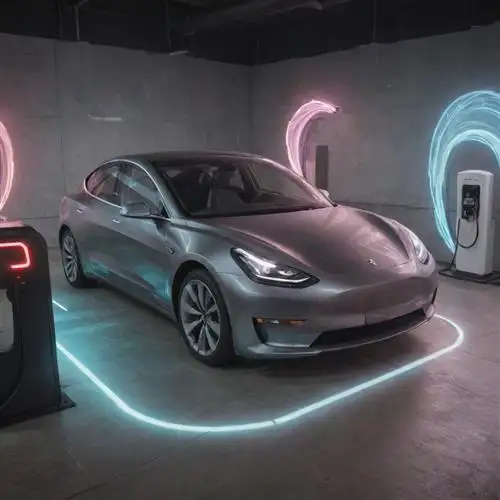
Optimize Driving Habits for Tesla Model 3 Efficiency
Optimizing driving habits for Tesla Model 3 efficiency is crucial to get the most out of your electric vehicle. One of the key factors that can impact your energy consumption is your driving style. Here are some strategies to help you achieve maximum efficiency:
Accelerate and brake smoothly: Rapid acceleration and harsh braking can significantly reduce your Tesla's energy efficiency. Instead, aim for gentle, gradual acceleration and braking. This not only helps preserve battery life but also provides a more comfortable driving experience.
Maintain a steady speed: Fluctuating speeds, such as frequent acceleration and deceleration, can negatively impact your energy efficiency. Try to maintain a consistent speed, especially on the highway, to maximize your Tesla's range.
Utilize regenerative braking: Tesla's regenerative braking system is designed to capture energy during deceleration and store it back in the battery. Take advantage of this feature by releasing the accelerator pedal early and allowing the car to slow down through regenerative braking.
Plan your route and driving conditions: Consider the terrain, weather, and traffic conditions before embarking on your journey. Avoid steep hills, heavy traffic, and extreme temperatures, as these can all impact your Tesla's energy consumption.
Precondition your Tesla: Use the Tesla app or in-car features to precondition the cabin temperature before you start your trip. This can help minimize the energy required to heat or cool the vehicle, improving overall efficiency.
Monitor your energy usage: Keep an eye on your Tesla's energy consumption display and adjust your driving accordingly. This can help you identify areas for improvement and fine-tune your driving habits.
Maintain your Tesla: Regular maintenance, such as checking tire pressure and keeping your Tesla clean, can also contribute to improved efficiency. Proper maintenance helps ensure your vehicle is operating at its optimal level.
Leverage Tesla Model 3 Regenerative Braking to Maximize Efficiency
One of the key features that sets the Tesla Model 3 apart is its advanced regenerative braking system. This technology allows the vehicle to recover a significant amount of energy during deceleration, which is then fed back into the battery pack. Mastering the use of this system is crucial for achieving maximum efficiency and extending your vehicle's range.
- Familiarize Yourself with the Braking System: Understand how the regenerative braking works in your Tesla Model 3. Experiment with different levels of braking intensity and observe the impact on the battery charge level. This will help you develop a feel for the system and learn how to use it effectively.
- Anticipate Stops and Slowdowns: Scan the road ahead and anticipate any upcoming stops or slowdowns. This will allow you to take your foot off the accelerator and let the regenerative braking system capture the energy, rather than relying solely on the traditional friction brakes.
- Modulate the Accelerator: Gently modulate the accelerator pedal to maintain a smooth, consistent speed. Sudden bursts of acceleration or braking can diminish the efficiency gains from the regenerative braking system.
- Use the Regenerative Braking Slider: The Tesla Model 3 allows you to adjust the level of regenerative braking through the touchscreen display. Experiment with different settings to find the one that works best for your driving style and the road conditions.
- Drive in Range Mode: The Tesla Model 3 offers a dedicated "Range Mode" that optimizes the vehicle's settings for maximum efficiency. This mode enhances the regenerative braking, reduces energy consumption, and can help you achieve the best possible range.
- Maintain Tires at Optimal Pressure: Properly inflated tires can reduce rolling resistance, which in turn improves the efficiency of the regenerative braking system. Check your tire pressure regularly and maintain it at the recommended levels.
- Monitor Your Driving Efficiency: The Tesla Model 3's dashboard and mobile app provide detailed information about your driving efficiency, including the energy recovered through regenerative braking. Use this data to analyze your driving habits and make adjustments to maximize your efficiency.
Maintain Optimal Tire Pressure for Tesla Model 3 Efficiency
Maintaining optimal tire pressure is crucial to achieving the impressive efficiency of the Tesla Model 3. The vehicle's design and engineering are optimized for aerodynamics and energy efficiency, but the tires play a critical role in maximizing the car's potential. Underinflated tires can significantly impact the Model 3's range and energy consumption, leading to subpar performance and a frustrating driving experience.
The Tesla Model 3 has specific tire pressure recommendations, typically between 42-45 PSI (pounds per square inch) for the front tires and 40-43 PSI for the rear tires. These pressures are designed to provide the best balance of rolling resistance, handling, and overall efficiency. Regularly checking and adjusting the tire pressure to the recommended levels is essential to maintaining the vehicle's optimal efficiency.
Underinflated tires increase the rolling resistance, which means the electric motor has to work harder to move the vehicle. This increased resistance translates directly into higher energy consumption and reduced range. On the other hand, overinflated tires can also negatively impact efficiency by reducing the tire's contact patch with the road, leading to decreased traction and handling.
- Check the tire pressure at least once a month, preferably when the tires are cold (before driving or after the vehicle has been parked for at least 3 hours).
- Use a high-quality tire pressure gauge to ensure accurate readings. Digital gauges are generally more precise than analog ones.
- Adjust the tire pressure to the recommended levels, as specified in your owner's manual or on the placard located on the driver's side doorjamb.
- Monitor the tire pressure regularly, as it can fluctuate with changes in temperature and driving conditions.
- Consider purchasing a set of high-quality, low-rolling resistance tires specifically designed for electric vehicles. These tires can further enhance the Model 3's efficiency.
- Avoid overloading your Tesla Model 3, as excess weight can also impact the tires and reduce efficiency.
Utilize Tesla Model 3 Efficiency Modes to Maximize Range
Maximizing the efficiency of your Tesla Model 3 is crucial for achieving optimum range and performance. One of the key ways to do this is by utilizing the various efficiency modes available in the vehicle. These modes are designed to help you tailor the driving experience to your specific needs and driving conditions, ultimately resulting in improved energy consumption and extended battery life.
The first and most well-known efficiency mode in the Tesla Model 3 is the "Chill" mode. This setting reduces the vehicle's acceleration, allowing for a more gradual and smooth throttle response. While this mode may not be the most thrilling for spirited driving, it can significantly improve your overall efficiency, especially in stop-and-go traffic or urban environments. By reducing the demand on the powertrain, the "Chill" mode can help you eke out more miles from your battery charge.
Another important efficiency mode to consider is the "Regenerative Braking" setting. This feature harnesses the energy generated during braking and converts it back into electrical energy, which is then stored in the battery. By adjusting the level of regenerative braking, you can tailor the vehicle's deceleration characteristics to your driving style and preferences. A higher regenerative braking setting can result in more aggressive deceleration, which can be beneficial for maximizing energy recovery and reducing the need for traditional braking.
In addition to these modes, the Tesla Model 3 also offers an "Efficiency" driving profile that can be accessed through the vehicle's touchscreen display. This profile optimizes various parameters, such as acceleration, regenerative braking, and climate control, to achieve maximum energy efficiency. By selecting this mode, you can expect to see a noticeable improvement in your overall range and efficiency, making it an essential tool for drivers who prioritize maximizing their Tesla's capabilities.
It's worth noting that the effectiveness of these efficiency modes can also be influenced by factors such as driving conditions, driving style, and environmental factors. For example, driving in hilly or mountainous terrain may require more frequent use of the "Chill" mode to maintain optimal efficiency, while driving in colder climates may necessitate adjustments to the climate control settings to balance efficiency and comfort.
Optimize Tesla Model 3 Charging for Maximum Efficiency
Optimizing Tesla Model 3 Charging for Maximum Efficiency is a crucial aspect of maximizing your electric vehicle's performance and reducing your energy costs. By understanding the key factors that impact charging efficiency, you can make adjustments to your charging habits and optimize your Tesla Model 3 for maximum range and cost savings.
One of the primary factors to consider is the charging speed. The Tesla Model 3 is capable of accepting a wide range of charging speeds, from the standard 120V household outlet to the high-powered 480V Superchargers. Charging at higher speeds can significantly reduce the time it takes to replenish your battery, but it's important to balance speed with efficiency. Higher charging rates can generate more heat, which can reduce the overall efficiency of the charging process. To achieve maximum efficiency, consider charging at the lower 240V Level 2 charging stations, which offer a balance of speed and efficiency.
Another important factor is the state of charge (SOC) of your battery. Tesla recommends keeping your battery between 20% and 80% SOC for optimal battery health and efficiency. Charging your Tesla Model 3 from a low SOC to a high SOC can be less efficient than charging from a higher SOC to a lower SOC. Consider splitting your charging sessions, such as charging to 80% during the day and then topping up to 100% before your next drive.
The ambient temperature can also impact the efficiency of your Tesla Model 3 charging. Extreme temperatures, both hot and cold, can affect the battery's ability to accept and store charge efficiently. If possible, try to charge your Tesla in a climate-controlled environment, such as a garage, to maintain optimal battery temperature and maximize charging efficiency.
Finally, the condition of your Tesla Model 3's charging equipment can also influence charging efficiency. Ensure that your charging cables and connectors are free of damage and that your home charging station or Supercharger is functioning correctly. Regularly inspect and maintain your charging equipment to maintain optimal performance and efficiency.
















